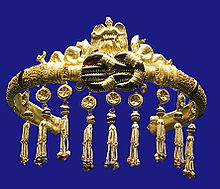Heracles knot
The Heracles knot , known as Hercules knot and nodus Herculis, herculaneus, Herculanus, Hamma herakleotikón , was considered very solid knots and was in ancient times a popular motif for jewelry. The name goes back either to the snakes that Heracles strangled as a child or to the way he wore the lion's skin knotted in front of his chest.
The Heracles knot probably corresponds to today's square knot .
history
The Hercules knot was a particularly tight knot in ancient times, especially in Greek and Roman cultures, which probably corresponded to our common square knot. Since neither sealing nor padlocks were known at that time , a tight knot was the only means of locking a box, a sack or the like. Thus showed Kirke the Ulysses the binding of a fixed node. Aiolos, in turn, locked the favorable winds in a sack for the return of Odysseus by tying a silver rope around it. For the Phoenicians trading people , tying a tight knot was of great value. Out of this devotion they tied the knot made of rope, carved from wood or cast in metal to a staff which they sent ahead as a sign of peace before they landed on a coast. This staff of peace, which was called the mighty Caduceus , has been further trained. In the hands of Greek artists, the knot with the ribbons hanging on it turned into two snakes that were wound around each other and now mystically had to serve for the different meanings. But the origin was only the knot, which we owe to the ancient world as a “padlock”.
Even after other types of closure had long been invented, the Hercules knot was still used in some cases. So it was used by name in magic. The bride also tied her sheep's wool belt with the Hercules knot around her tunic , which the groom had to undo on the wedding night. In this way the bridegroom should be as happy with the procreation of the children as Hercules, whose procreative power was known to be shown in the 50 daughters of Thespios . At least that's what Festus said .
Böttiger, on the other hand, was of the opinion that the belt was tied in this way as a sign of the strength of the new marriage covenant. However, this would have been a bad omen if this mark of firmness had to be removed from the bridegroom.
The knot probably had no symbolic meaning at all. The belt had to be tied and this was done with the Hercules knot because it was simply tighter than others.
The Roman scholar Pliny the Elder (23 to 79 AD) claimed of the Hercules knot at the time: "Wounds that are closed with the Hercules knot heal faster". In addition, by tying the middle fingers of the right hand together, the knot is said to heal excessive sweating on the head and watery eyes. Pliny also thought that it would be helpful to initiate a quick birth if the child's father put his belt around the pregnant woman and tied it with the knot. Then he spoke the formula: "I have bound and I also loose."
Surgeons, above all Kurt Sprengel , also assigned the name nodus Herculeus to their surgeon's knot , which, in addition to sutures, was also used for bandages for broken bones and dislocations . It was also used as a love knot in Virgil's sexual practices .
Various Hercules knot representations
Detail - knot in lion skin ( Versailles )
Hercules fountain in Bayreuth
Individual evidence
- ^ J. Turner: History and Science of Knots. ISBN 981-02-2469-9 , p. 399, The true Love Knot : A famous Knot in the Greek and Roman culture was the Hercules Knot.
- ↑ Claudia Schopphoff: The belt. Function and symbolism of a garment in antiquity and the Middle Ages . 2009, p. 33, 124, 125, 309 ( limited preview in Google Book Search [accessed May 17, 2019]).
- ↑ a b c General Encyclopedia of Sciences and Arts. Second section H-N . 1829, p. 147 f . ( Full text in Google Book Search [accessed May 17, 2019]).
-
↑ J. Turner: History and Science of Knots , (1995) p. 400.
CL Day: Knots and Knotlore - A study in Primitive Beliefs and Supperstitions, Western Folklore N ° 9 (1959) 229-256. - ↑ Excursus: The conversations of Aloisia Sigaea, 5th conversation, loosening the Hercules knot .
- ^ A b Karl August Böttiger: Greek vase paintings . 1797, p. 103 ( full text [accessed May 17, 2019]).
- ↑ Knot world .
- ^ Google Books, Virgil's Eklogen .






